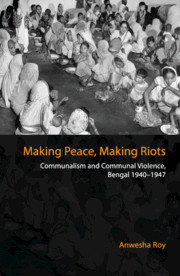Book contents
- Frontmatter
- Frontmatter
- Contents
- Maps and Figures
- Acknowledgements
- Abbreviations
- Glossary
- Introduction
- 1 The Dacca Riot, 1941
- 2 Famine 1943 – Towards a Hardening of Community Identities
- 3 From Community to Communal: The Bengal Secondary Education Bill and the Idea of Pakistan
- 4 The Great Calcutta Killing, August 1946
- 5 Noakhali Riots, October 1946
- 6 A Test of Faith: Gandhi in Noakhali and Calcutta 1946–47
- Concluding Remarks
- Appendix 1
- Appendix 2
- Appendix 3
- Appendix 4
- Bibliography
- Index
1 - The Dacca Riot, 1941
Published online by Cambridge University Press: 23 October 2018
- Frontmatter
- Frontmatter
- Contents
- Maps and Figures
- Acknowledgements
- Abbreviations
- Glossary
- Introduction
- 1 The Dacca Riot, 1941
- 2 Famine 1943 – Towards a Hardening of Community Identities
- 3 From Community to Communal: The Bengal Secondary Education Bill and the Idea of Pakistan
- 4 The Great Calcutta Killing, August 1946
- 5 Noakhali Riots, October 1946
- 6 A Test of Faith: Gandhi in Noakhali and Calcutta 1946–47
- Concluding Remarks
- Appendix 1
- Appendix 2
- Appendix 3
- Appendix 4
- Bibliography
- Index
Summary
The 1940s in Bengal were marked by a steady rise on the communal barometer. It is only fitting that I begin this study with an analysis of the first major riot of the decade. The Dacca riot of 1941 engulfed not only the city of Dacca but also the countryside, specifically the thanas of Raipur, Shibpur and Narsinghdi. It was in a way a harbinger to the horrors that would unleash in 1946 – the Great Calcutta Killing and the Noakhali riots. Described as ‘a transition to a new phase’ by Suranjan Das, it quantitatively and qualitatively ushered in a new kind of violence in the province. Hence it is, in several ways, key to understanding the later riots that shook Bengal a year before independence and partition.
It is necessary to provide a background sketch of the various socioeconomic and political factors that led to the riot. Like most districts of East Bengal, Dacca too had a substantial Muslim population. In 1872, census enumerations had found that Muslims constituted 56.5 per cent of the population and each successive enumeration showed a marked increase in this percentage. Their rate of population growth between 1872 and 1901 was found to be nearly twice as much as that of Hindus. Muslims predominated in almost every part of the district, but their population was highest in the northern thanas of Raipura and Kapasia, and lowest in Dacca city, where they were outnumbered by Hindus. The proportion of Hindus was lowest in the Narayanganj sub-division. Namasudras were the dominant Hindu caste. They were numerous throughout the district, but mainly concentrated in Srinagar, Nawabganj and Keraniganj thanas. In the 1941 riot, this pattern of population distribution significantly determined the nature of violence. Hindu rioters were the chief aggressors in Dacca city, whereas Muslim rioters wreaked havoc in rural areas.
Dacca had also been strongly influenced by the Wahabi and Faraizi movements, with their emphasis on avoidance of Hindu and other syncretic rites and rituals. Although numerically a minority, Hindus formed the bulk of the upper and middle classes in the city, with wealth and education being largely concentrated in their hands. In Dacca, like everywhere else in East Bengal, Hindus dominated trade and moneylending. The ratio of moneylenders was the highest in Dacca as compared to the rest of Bengal.
- Type
- Chapter
- Information
- Making Peace, Making RiotsCommunalism and Communal Violence, Bengal 1940–1947, pp. 26 - 67Publisher: Cambridge University PressPrint publication year: 2018



